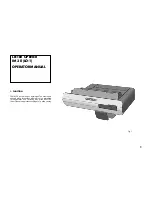
Subject to change without notice
12
[2] AUTOSET
Briefly pressing this pushbutton results in an automatic
instrument setting selecting Yt mode as the default. The
instrument is set to the last used Yt mode setting
(CH I, CH II
or
DUAL).
The instrument is set automatically to normal (undelayed)
time base mode, even if the previous Yt mode was present
in combination with search (“sea”), delay (“del”) or triggered
delay (“dTr”) time base mode.
Please also note ”AUTO-
SET” in section “First Time Operation”.
Automatic CURSOR positioning:
If
CURSOR
lines are displayed and AUTOSET is chosen the
CURSOR lines are set automatically under suitable conditions
and the readout briefly displays “SETTING CURSOR”.
If the signal height is insufficient, the
CURSOR
lines do not
change. In
DUAL
mode the
CURSOR
lines are related to the
signal which is used for internal triggering.
Voltage CURSOR
If voltage measurement is present, the CURSOR lines are
automatically set to the positive and negative peak value of
the signal. The accuracy of this function decreases with
higher frequencies and is also influenced by the signal‘s
pulse duty factor.
Time/Frequency CURSOR
If complex waveforms such as video signals are applied, the
cursor lines may not align exactly with one period and give a
false reading.
[3] INTENS/FOCUS
– Knob with associated LEDs and TRACE
ROT.-pushbutton.
If the readout (RO) is not switched off, briefly pressing the
READOUT pushbutton switches over the INTENS/FOCUS
knob function indicated by a LED in the sequence A, FOC,
RO, A. In condition READOUT deactivated, the switching
sequence is A, FOC, A.
“A”:
The INTENS/FOCUS control knob adjusts the signal(s)
intensity. Turning this knob clockwise increases the intensity.
Only the minimum required trace intensity should be used,
depending on signal parameters, oscilloscope settings and
light conditions.
“FOC”:
The INTENS/FOCUS control knob adjusts both the trace and
the readout sharpness. Note: The electron beam diameter
gets larger with a higher trace intensity and the trace sharpness
decreases. This can be corrected to a certain extent. Assuming
that the trace sharpness was set to optimum in the screen
centre, it is unavoidable that the trace sharpness decreases
with an increasing distance from the centre.
Since the settings of the signal(s) intensity (A) and the
READOUT (RO) are usually different, the FOCUS should be
set for optimum signal(s) sharpness. The sharpness of the
READOUT then can be improved by reducing the READOUT
intensity.
“RO”:
The INTENS/FOCUS control knob adjusts the READOUT
intensity. Turning this knob clockwise increases and counter
clockwise decreases the intensity. Only the minimum required
intensity should be used.
“SET”
MAIN MENU-pushbutton
[31]
calls the selected menu
item, starts a function or switches a function on/off.
Pulldown menus:
After pressing a pushbutton which calls a Pulldown menu, the
instrument parameter settings are still displayed. The readout
only changes in respect to the called parameter (e.g. input
coupling) and now shows all selectable parameter options (in
case of input coupling: AC, DC and GND). The previously displayed
parameter doesn‘t change but is displayed highlighted. Each time
the pushbutton is briefly pressed the next parameter becomes
active and highlighted, as long as the Pulldown menu is displayed.
Without further pressing the pushbutton, the Pulldown menu
extinguishes after a few seconds and the selected parameter is
displayed in the normal way.
C: READOUT Information
The readout alphanumerically displays the scope parameter
settings, measurement results and CURSOR lines. Which
information is displayed depends on the actual instrument settings.
The following list contains the most important display information.
Top of the graticule from left to right:
1st
time deflection coefficient
2nd trigger source, slope and coupling
3rd
operating condition of delay time base
4th
measuring results
Bottom of the graticule from left to right:
1st
probe symbol (x10), Y deflection coefficient and input
coupling channel I
2nd “+” symbol (addition)
3rd
probe symbol (x10), Y deflection coefficient and input
coupling channel II
4th
channel mode
The trigger point symbol is displayed at the left graticule border
line. The CURSOR lines can take any position within the graticule.
Description of Controls
The large front panel is, as usual with Hameg oscilloscopes,
marked with several fields.
The following controls and LED indicators are located on the top,
to the right of the screen, above the horizontal line.
[1] POWER –
Pushbutton and symbols for
ON (I)
and
OFF (O)
.
After the oscilloscope is switched on, all LEDs are lit and an
automated instrument test is performed. During this time the
HAMEG
logo and the software version are displayed on the
screen. After the internal test is completed successfully, the
overlay is switched off and the normal operation mode is
present. Then the last used settings become activated and
LED
[3]
indicates the ON condition.
Controls and Readout
POWER
AUTOSET
INTENS / FOCUS
SAVE
RECALL
50 MHz
ANALOG OSCILLOSCOPE
HM504-2
Instruments
!
TRACE
ROT.
2
1
3
4
5
A
FOC
RO
RM
Summary of Contents for HM504-2
Page 2: ......
Page 3: ...O s c i l l o s c o p e H M 5 0 4 2 Manual English...
Page 39: ...37 Subject to change without notice Front Panel HM504 2...
Page 40: ......
Page 41: ...LEER...















































